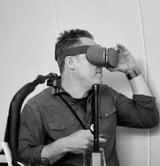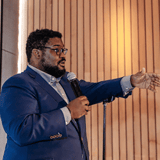Log in or create a free Rosenverse account to watch this video.
Log in Create free account100s of community videos are available to free members. Conference talks are generally available to Gold members.
Summary
Measuring the success of research efforts is a critical capability in maturing our discipline and increasing our influence. This Advancing Research call is an opportunity to hear about “learning velocity,” how it’s being applied at Fidelity Investments, and what that could mean for you. Fidelity’s Jen Cardello, head of UX Research & Insights, and Jen Otto, head of Research Operations, shares how learning velocity has become a significant outcome that drives both ResearchOps initiatives (e.g., democratization) and the way they conduct and measure the effectiveness of research at Fidelity. Jen and Jen outline what learning velocity is and how it fits into Fidelity’s outcomes-based approach to research strategy.
Key Insights
-
•
Fidelity's UX research team faced huge scale challenges with 600+ product teams and only 35 researchers, making ubiquity impossible.
-
•
Focusing on research quantity, such as more studies faster, is counterproductive and considered poison; instead, learning velocity is the priority.
-
•
The democratization program trained over 200 designers and product partners to independently run unmoderated usability tests, cutting insight turnaround from 14 days to 3 days.
-
•
Quality control in democratization was ensured via a buddy system and approval gating in the testing platform to maintain high research standards.
-
•
Lighthouse centralized all UX research insights with strict standards on metadata and titling to reduce redundancy and make insights easily discoverable.
-
•
Lighthouse integration with collaboration tools like Microsoft Teams encouraged organic sharing and started building insight virality and empathy culture.
-
•
Continuous Discovery and Feedback (CDF) introduced a steady sprint cadence with dedicated researchers per initiative, aligned to living learning agendas prioritizing research questions.
-
•
CDF enabled transparency and cross-team collaboration, letting teams track when questions were posed and answered, speeding prioritization and strategic alignment.
-
•
Rapid recruiting innovations, including app push notifications and online scheduling, transformed a 4-6 week participant recruitment process down to hours or days.
-
•
Cultural acceptance was crucial; designers embraced democratization for autonomy and faster validation, while researchers accepted a shift from execution to facilitation roles.
Notable Quotes
"We cannot be everywhere. So is the goal to conduct more studies faster? And we said no, it’s not. That’s poison."
"The focus is on helping the organization learn faster to make smart, human-centered decisions."
"We had a backlog that made turnaround times at least 14 days; now teams can get answers within three days through democratization."
"Lighthouse reduces time spent searching for insights by having everything in one place."
"Democratization is about letting go of some research and enabling teams to learn from customers directly."
"The buddy system ensures quality by requiring study review and approval before launching."
"Continuous Discovery runs every two to three weeks with dedicated researchers tied to specific product journeys."
"Recruiting used to take 4 to 6 weeks; now, with app push notifications, we can fill interviews within an hour and a half."
"Designers want to learn how to do research because they get autonomy and faster feedback, not just waiting weeks."
"We shifted from an output mindset of how much work we do to an outcome mindset of the impact our work delivers."
Or choose a question:
















More Videos

"The future of urban living depends on our commitment to environmental justice."
Lena ShenkarenkoCollaborative Wireframing for Creating Team Alignment and Shipping Better Products
October 21, 2020

"The journey metaphor is better than the sprint because transformation doesn’t have a finishing point."
Bob Baxley Sara Asche Anderson Sharon Bautista Frank Duran Jamie Kaspszak Abbey Smalley Sylas SouzaTheme 4: Discussion
January 8, 2024

"Adding inclusivity to the career ladder took three years and this is still a living document with room for change."
Laine Riley ProkayHow DesignOps can Drive Inclusive Career Ladders for All
September 30, 2021

"We design with our biases and subjectivities, so we must work with diverse stakeholders to avoid tunnel vision."
Paul Pangaro, PhDSystems Disciplines: Table Stakes for 21st Century Organizations
June 6, 2023

"The conference is not an endpoint, but a path to broadening our understanding of designing with AI."
Uday Gajendar Louis RosenfeldDay 1 Welcome
June 4, 2024

"Discovery doesn’t usually come with a launch party or even its own Jira ticket, but it’s what turns speed into progress."
Bianca JeffersonFrom Sprints to Systems: Operationalizing Continuous Discovery Through DesignOps
September 10, 2025

"What am I personally doing to contribute to the dynamics that stand in the way of better futures?"
Chris GeisonTheme 1 Intro
March 9, 2022

"We encourage canceling programs very fast if research shows lack of need to avoid wasted effort."
Teresa SwinglerLook, Up in the Sky! UX/UI for Aerospace
October 27, 2022

"The State Department removed burdensome medical requirements, allowing people to self-attest their gender on passports."
Amy Paris Danielle ThierryDelivering Equity: Government Services for All Ages, Languages, Sexual Orientations, and Gender Identities
December 9, 2021

















